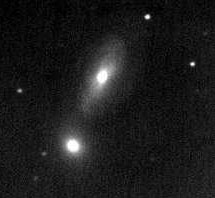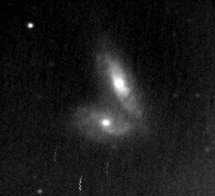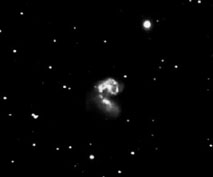

Images of interacting galaxies by CCD imager Damian Peach. Left: NGC 3227 and NGC 3226 in Leo; right: the 'Siamese Twins' in the Virgo Cluster, NGC 4567 and NGC 4568. 300mm SCT, Starlight Xpress CCD.
J. Brit. Astron. Assoc., 109, 2, 1999, pp 51-52


Images of interacting galaxies by CCD imager Damian Peach. Left: NGC 3227 and NGC 3226 in Leo; right: the 'Siamese Twins' in the Virgo Cluster, NGC 4567 and NGC 4568. 300mm SCT, Starlight Xpress CCD.
For deep sky observers, Spring is eagerly awaited as it is 'open season' for galaxies. In mid-evening in mid-April, our Milky Way skirts the northern horizon, allowing the observer to see the more distant Universe uncluttered by dust, gas and clusters. The four hour wedge of Right Ascension with Polaris at the apex, Regulus to the east and Arcturus to the west contains the galaxy-rich constellations of Draco, Ursa Major, Canes Venatici, Coma Berenices, Leo and its cub Leo Minor, Sextans, Corvus and of course Virgo. All are stuffed with enough galaxies to keep the enthusiast happy for years.
The richest nearby clusters of galaxies are on view here, the densest being Edwin Hubble's 'Realm of the Nebulae' centred between Denebola (Beta Leonis) and Vindemiatrix (Epsilon Virginis). This region has always been rewarding to explore, so numerous are the galaxies, and the Virgo–Coma Cluster must be the 'faint fuzzy' region par excellence! However the majority of the members of the Virgo Cluster are just too far away to show details visually unless large reflectors are available. Photographers have enjoyed more reward, but it is with the arrival of CCDs that galaxies have come to the fore with amateurs. The larger apparent image scale, the shorter exposures, and available image processing have enabled detail to be revealed in galaxies in a way undreamed of a decade ago. Observers are now prepared to try obscure galaxies and clusters that would have been deemed 'too difficult' in the past.
Single galaxies still command great interest, but the aesthetic pleasure of seeing more than one galaxy in a field of view cannot be denied. Most galaxies are gregarious and travel through space-time in groups, clusters and superclusters. In such areas of heightened galaxy density, individual galaxies will influence neighbours with gravitational attraction, and occasionally there is evidence of direct interaction, even collisions. Some of the effects are the province of the professional astronomer. The Magellanic Stream, detected by radio astronomers, appears to result from tidal forces due to the Milky Way Galaxy's gravity disrupting our small neighbouring galaxies, the Magellanic Clouds, in close encounters in aeons past. The famous Leo triplet of Messier 65, 66 and NGC 3628 also demonstrates gravitational effects, especially on NGC 3628 which has a warped disk and a faint 260,000 light-year-long tail that is detected on the deepest photographs and at radio wavelengths. This is thought to have resulted from a close encounter with M66 some 800 million years ago.
The Hubble Space Telescope has revealed spectacular details of the aftermath of galaxy collisions, most notably the image of the 'Cartwheel Galaxy' in Sculptor, with its ring of blue showing star formation resulting from the encounter. But how about examples for the amateur? Undoubtedly the best example of an interacting system is one of the most observed, and beloved of the CCD community. Messier 51 is to the CCD observer what the Great Orion Nebula is to the astrophotographer (Figure 1). The Whirlpool itself is a majestic Sc-type spiral, one of a very few where spiral structure can be glimpsed in modest amateur telescopes. Its irregular companion, NGC 5195, is to the north and clearly connected through an extension of a larger spiral arm. Photographs and CCD images show enhanced activity at the interface between this streamer and the peculiar galaxy, star formation being the result of increased energy available through the interaction.
Another pair in Canes Venatici, just a degree north-west of (, is of interest. A small 12th magnitude irregular, NGC 4485 appears to be pulling material from a larger dusty barred spiral, NGC 4490, 4 arcminutes to the south (Figure 2). Clumpy material appears to line a stream between the pair, though they are not joined visually even on deep images. Star formation is vigorous in each galaxy. NGC 4490 can be seen to be mottled visually in telescopes of 300mm aperture and above.
Leo has interesting pairs and groups in addition to the Leo Triplet mentioned above. One has a marked contrast in class of galaxy, a small elliptical (NGC 3226) interacting with a typical Sb spiral, NGC 3227 (Figure 3). Tidal plumes can be detected only with professional equipment, but they form a pleasing pair for amateurs.
Virgo has vast numbers of galaxies, and in this large nearby cluster many close encounters can be expected. One of the best known is the Siamese Twins, NGC 4567 and NGC 4568 (Figure 4). These Sc spirals are apparently in contact and their centres are a mere 1.3 minutes apart. The odd feature here is the lack of apparent disruption from their perceived proximity, no tidal tails having formed, no excessive star formation being apparent. It is possible that they have greater separation in the line-of-sight than is measured, or the orbital circumstances are not favourable for typical changes to occur.

NGC 4038 and 4039, the Antennae, imaged by Nik Szymanek and Ian King.
Finally, low in the south lurks the celestial crow, Corvus, and arguably the best colliding pair in the sky, nicknamed the Antennae. NGC 4038 appears to have been a typical spiral and is now having intimate relations with another spiral, NGC 4039 (Figure 5). The resulting tidal tails are faint but detectable even with amateur equipment, at least in part, and the formation was convincingly modelled in simulation by Alar and Juri Toomre as long ago as 1972. The pair of galaxies are so distorted that classification of the originals has been difficult, but a dusty Sb or Sc and relatively dust-free S0 are likely candidates, each rotating in opposite directions. The loss of rotational energy occurred in producing the tails, and the star formation remains fierce, especially in NGC 4038 which had the majority of the raw ingredients. The starburst has been dramatically revealed in photographs by David Malin at the AAT, and more recently by HST.
The clear skies of spring beckon galaxy hunters. Look for evidence of galaxy evolution in our neighbouring clusters of galaxies, so richly displayed during this season.
Return to Journal 1999 April contents page